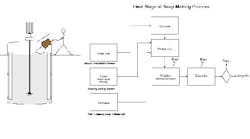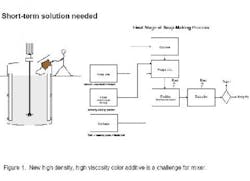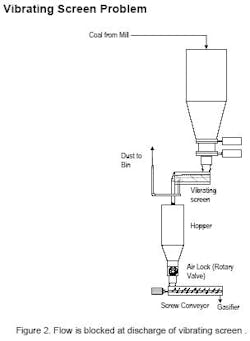Question from May's Chemical Processing
The research department is introducing a new color additive. This additive is blended with a 2-hp high-sheer mixer prior to addition to a weigh-cell feeder (Figure 1). The feeder drains to a soap plodder (mixer) and eventually product is extruded as bar soap. The specific gravity of the new liquid is 20% higher and viscosity is 10-times greater than the additive used in the past. Calculations show that the power draw by the high-shear agitator will exceed the motor limits. Because the new product will roll-out in a few weeks, we need a short-term solution — quick. What alternatives will allow production to continue?
Click to enlarge Figure 1
Add a portable mixer
Consider mixing with a portable mixer with a marine impeller. This type of impeller produces more flow than a high shear mixer — with less horsepower. An alternative might be to feed the high shear mixer with the portable mixer. At our plant, we had similar problems. Where we could not resolve the problem by modifying the process, we decreased the size of the blade by cutting some of the metal off the blades of a turbine impeller. This decreased the load on the motor. This must be done carefully to avoid a torque problem from an unbalanced impeller. We added re-circulating lines in our tanks, so we were able to eliminate dead spots on corners of the tank. Generally, soap-making has heat available (steam or electric) at hand so heating the tank might help resolve the problem. It might also be worth looking at heating the concentrated colorant, if it is in liquid form. Eventually, a different mixer should be considered.
Werner Buchmann, chief chemist
ProClean of Arizona, Inc. Phoenix, Ariz.
Reduce the mixer speed
Borrow a harmonic drive system, if available, to reduce the motor speed. High shear mixers are typically direct-drive, without a gear reduction. Reduce the speed since the power required by the agitator is related to the speed by a cubic function (P = 6.566 × 10-14 (NpN3D5r) reducing the speed by 20% will decrease the power draw by more than 50%. (Np is the manufacturer’s power number, N is the speed in rpm, D is the impeller diameter in inches and r is the solvent specific gravity.) Reducing the speed will have the less effect on the mixing time than reducing the diameter because the flow will be only slightly affected (Q = ND3Nq/231). (Nq is the impeller flow number and Q is the pumped flow in gpm.) The shearing action will be decreased, however by reducing the speed. The only problem may be the mounting plate and shafts, which might be difficult to machine in time. Another idea is to relocate the agitator off-center. This will reduce the power draw.
Lyle Bleile, design engineer
Amerock Corporation, Rockford, Ill.
Try a three-prong approach
First, have research conduct some experiments on the final color solution which includes the new additive. If the additive is non-Newtonian, the color solution may be shear- thinning. Ideally, the result of the experiments should be a shear rate versus viscosity curve at the shear that the additive will be subjected to in the high shear mixer. It will be difficult to be exact on the shear. Talk to the manufacturer about tip speed. Ask them to look at ways to reduce the viscosity and density in the solvent.
Second, assuming non-Newtonian characteristics, consider processing at a higher temperature. Viscosity is a function of temperature and is often inversely proportional to temperature. Have research provide a shear rate vs. viscosity curve as a function of different temperatures and re-calculate power draw requirements.
Third, look at ways to reduce the feed rate of the new colorant without severely affecting mixing time or labor costs.
Mohammad Babar, principal systems engineer
Unilever HPC, Jefferson City, Mo.
Use a pump
Presumably the new color additive is miscible with the soap mix, just more viscous and denser than before. We need to ensure that the color mix doesn’t settle, and that we can thoroughly disperse it. I suggest try adding by pump. Be aware that the pumping rate of a pump will never match an agitator. Install a stainless steel dip tube (It must be rigid!) adjacent to the inlet area of the high shear mixing head. The exact position will depend on the type of high shear head. The feed rate also will be important. Ensure that the rate isn’t too fast or the color material won’t be entrained into the high shear head with sufficient solvent (water). This is already done with some high shear mixers. With some manufacturers, the tube can be fixed with stainless steel fittings to one of the support rods and the outlet from the dip tube aligned so that the tube outlet is level with the inner edge of the lower support ring of the mixing head. This set-up could be more difficult for some manufacturers. The R&D laboratory could test this working scheme if they have the equipment. Obviously speeds and throughput calculations would need to be checked. They would need to check the relative feed rate of the color additive that ensures it is adequately dispersed. If done correctly, the lab phase should take about a day. Obtaining the tube, etc, and installing might take three days. The stainless steel tube would need to be angled appropriately for best results. Then, a trial run at scale would be required.
Chris Moreton, VP, Pharmaceutical Sciences
Idenix Pharmaceuticals, Cambridge, Mass.
Install a VFD, replace the impeller
At the bare minimum the 20% increase in specific gravity will call for 20% more horsepower, and most likely the 10-fold increase in fluid viscosity will also require additional horsepower. The assumption being that an increase will take us into transitional flow regime in the Reynolds number vs. impeller drag coefficient curve, where increasing viscosity results in increased drag (power draw) on the impeller. The existing mixer will probably not work and if it does, the mixing will take longer. Here are a few options, some of which may be possible with the tight deadline:
- If mixer is equipped with a variable frequency drive, or a VFD is available, perhaps the mixing requirements can still be met by slowing the mixer shaft draw and shaft speed. The mixer power draw is proportional to the cube of the shaft speed. Therefore a small decrease in shaft speed would result in a noticeable drop in horsepower drawn at the shaft. I estimate that a 7% drop in RPM would be required to account for the increase in density.
- Perhaps the "shear" mixer utilizes a "saw tooth" type (a.k.a Cowles) impeller, which is readily available and relatively inexpensive. A number of vendors can supply impellers quickly. If so, we can take advantage of the relationship between mixer motor draw and impeller diameter — mixer shaft horsepower is proportional to the impeller diameter to the 5th power (D5). A very small decrease in impeller diameter causes a noticeable drop in mixer horsepower; roughly a 4% drop in impeller diameter would be required to account for the increase in density.
- Check with the manufacturer of the high shear mixer. The power frame of the mixer may in fact allow for a larger-hp motor to be put on the machine and still stay within the mechanical limits of the shaft system.
Shear mixers normally are most effective when their impeller peripheral speeds are in the 3,000 to 5,000 ft/min. range. Dropping the shaft speed or impeller diameter would effect the “tip speed” of the blade so if both new impeller and VFD are available one perhaps could re-tune the existing mixer to provide the proper process result or at worst case make up smaller batch sizes.
Tim Geiger, engineer
Mattoon & Lee Equipment, Farmington Hills, Mich.
Meter in the concentrate
The first thing I would try is to replace the motor on the high shear mixer. It should be possible to get a 5-hp motor to replace the 2-hp motor. Motors are relatively inexpensive and readily available on both the new and used market. The only problem might be the mounting plate; making a new one might be easy or hard, depending on your shop. Another solution is to meter the additive in. Add it slowly instead of all at once. By working with R&D, the people who created this situation, it might be possible to change the order of formulation. That way, the additive is more readily dispersed and diluted, hence not as viscous. It might also be possible to dilute the additive in one of the other components prior to addition to the main batch. The final suggestion is to go on vacation just before roll out, and claim it was working fine before you left.
Kevin Cappo, CHMM Corp. HSE director
Spraylat Corporation, Chicago, Ill.
The high shear mixer might be okay
Power curve calculations are often not useful in these situations especially in non-Newtonian fluids; the 2-hp mixer may do the job. If not, you could split the additive into two smaller batches. This may require two small tanks with portable mixers since the high sheer mixer will not be submerged. One other problem will be additional labor costs because of the time spent to split the batches. An alternative might be to change the size of the mixing blade in the high shear mixer. You can run a couple of experiments with the different rotors and stators (impellers) to measure the current draw using water in the production batch tank.
Nate Blackburn, technical director
Increte Systems, Inc., Odessa, Fla.
Replace the motor
Most motors come in different horsepower on the same frame and aren’t hard to find on the market. I would change the motor horse power to what is needed. This solution will work well as long as the motor shaft and agitator shaft don’t appreciably change. Another problem might be the draw for a larger motor if the wiring or heaters are sized too close to limit. Starters should not be a problem as long as the motor isn’t too large. Alternatively, a smaller impeller could be used, though this would affect the mixing time and reduce shear from agitation. This would reduce the energy input into the mixer so that the existing motor would work with the new material.
Michael J. Kirkman, chemical engineer
AREVA NP Inc., Richland, Wash.
Put some heat on it
Increase liquid temperature before the blender. Check viscosity-temperature data to see if increasing temperature will lower the viscosity enough to stay within the power draw. A bayonet heater or some simple retrofit might suffice. As a precaution, check if there is any negative effect on the product by being heated during processing.
Charles W. Lamb, senior process engineer
Teris L.L.C., El Dorado, Ark.
Raise the temperature
A solution might be to raise the temperature of the mix tank, assuming a higher temperature reduces the viscosity and the power draw. Some tests would be required before considering heat-tracing the tank and insulating. I thought about splitting the stream between two tanks but that would have its own problems. Another thought was to use a different mixer without such a high power draw but in practice this approach tends to slow down the process and you do not get good dispersions — so it creates more issues that it solves.
Ralph A Heasley, executive director product development
Xanodyne Pharmaceuticals Inc., Newport, Ky.
Try a trip to the bone yard
The easiest change you can make is to increase the temperature of the mixing solution. This should decrease the viscosity. What could work just as well is to change the blades on the unit, or the type of impeller; use one with a smaller diameter which draws less power, but might not do as good a job. One other idea is to find a variable frequency drive and lower the speed; again, this may cause fisheyes (clumps of unmixed solid mixed with air) or increase blending time. A trip to the bone yard for a larger mixer or a one from a used-equipment dealer could be a solution if you can do this in the days allowed.
Dr. Rudy Lisa, senior research associate
BASF Corp., Wyandotte, Mich.
Reduce the speed
Chances are the high-shear agitator is “over-agitating” anyway. Reduce the current draw by installing a frequency-modulation type speed controller (adaptable to any AC motor with minimal power loss). This will lower the speed of the agitator by 20% or more, until the motor does not exceed its name-plate amperage rating. If, by doing so, the mixing action is still satisfactory for the downstream process, you're off the hook temporarily. You may want to consider replacing the impeller (rotor, stator) or the whole mixer eventually.
Gueric Boucard, president
TEXAROME Inc., Leakey, Texas
Go with slower, larger motor
Clearly there is a problem. Since power draw is proportional to viscosity times speed squared times diameter cubed, reducing the speed by 66% and the blade diameter to 80 % of its original size will require a motor 2.2 times larger. Factoring in the effect of density (power is proportional to density × speed cubed × impeller diameter to the fifth power), the motor needs to be 1.2 × 2.2 = 2.64 times larger, or 5.28-hp. Assuming that the existing motor is a 1,800 rpm with a 1.0 safety factor, my quick fix solution is to change the motor. Go to a 1,200-rpm 5-hp motor with a 1.15 safety factor premium efficiency. Next, if possible, I would cut the blades down 20%. Obviously, the existing agitator is only 2-hp, which indicates that the application is not a viscous application. Instead of cutting down the blades why not replace the high shear agitator blades with high efficiency blades? Depending on the specific power numbers (Np) of the agitator, this would be a better choice and may eliminate the need to change the motor horsepower or speed. Another alternative would be to select the larger motor and provide it with a variable frequency drive.
Jim Collett, senior project engineer
Emerald Hilton Davis LLC, Cincinnati, Ohio
Experiment
I would try the following ideas:
- Raise the temperature to lower the viscosity. (Avoid overheating to oxidize any organics in the color concentrate.)
- Lower the speed of the high shear mixer.
- Use a smaller blade on the high shear mixer.
- Use a different type (less aggressive) blade on the high shear mixer.
- Add a clamp-on mixer that will mix at the higher viscosity.
If this doesn’t work, another solution is to mix in smaller batches in a smaller vessel. For a significantly higher viscosity, a different type of mixer may be needed. I recommend a sigma blade, ribbon, paddle etc.
Gary D. Robertson, engineer
Valley Equipment Co., Jonesborough, Tenn.
Your solution is dilution
Since the viscosity of the color concentrate may be responsible for raising the viscosity of the final mixed solution, why not dilute the concentrate (dye)?Your laboratory could run some experiments to see if this works. The concern would be the water balance. Plodders produce some heat but not enough if a lot of solvent is added.
Scott Shaffer, president
AMS Materials LLC, Fruit Cove, Fla.
Change the motor style
A quick possible solution: Rent a similar mixer, but higher-hp-rated one. Another alternative would be to replace the motor. Is the motor mounted on the outside and to a plate or is it a C frame which has a plate at the front of the motor which mounts directly to the mixer? If it is mounted on the outside to a plate, the 2-hp motor can be de-mounted. An adapter plate can be made and bolted to the existing frame. Then, a larger horsepower motor can be mounted on a stand a few inches above the adapter plate. The new motor can then be made to drive the mixer via a jack shaft similar to the ones go-carts use. The output shaft of the new motor would have a pulley with a belt going to a same-size pulley now mounted on the jack shaft which is coupled to the mixer drive. If the new motor is the same rpm as the old one, using same-sized pulleys will give the same speed. Since I’m not an engineer, the power requirements would have to be confirmed. The parts are generally available from suppliers overnight if needed. The motor adapter can easily be manufactured from sheet steel and simple gussets welded or bolted in to make the assembly rigid enough for the horsepower requirements.
Joe Sprow, industrial specialist
Bureau of Engraving and Printing, Washington, DC
Consider various options
I came up with some short-term and long-term solutions. Short-term improvements include: 1) buy off-the-shelf larger motor — if the shaft and plate modifications are not severe; 2) explore increasing the motor voltage; 3) look at increasing the temperature of the mix tank; 4) replace the impeller (rotor, stator) with one that requires less power or a smaller one. Purchasing a larger motor should be fairly easy but mounting it to the existing agitator might be a challenge. Increasing the temperature in the tank could be done with heat-tracing and insulation — the results might not be enough; check with R&D first. Replacing the impeller might be possible in a short time. Cutting the impeller back may cause an imbalance in the shaft if not done correctly.
Long-term solutions are: 1) reduce the speed with a belt-driven pulley; 2) replace the high shear mixer with a pump and static mixer or in-line mixer; 3) consider a viscosity-modifier to reduce the viscosity of the batch; 4) make some electrical changes; 5) replace the mixer with a better design. Replacing the current motor with a belt-drive pulley would reduce the power draw but it also would increase the mixing time. The existing pump might be okay in recirculation-mode using a static mixer. A more expensive option would be an in-line mixer but the results would be better than a static mixer. Mixing time would definitely be increased with either a static mixer or inline mixer. Talk to motor manufacturer about whether increasing the motor voltage with a transformer might be an alternative to consider. (Motor wiring etc. has safety factor built in which might allow increased voltage.) In the same vein as reducing the speed, consider buying an off-the-shelf motor with a lower rpm if a reduction in mixing efficiency can be accepted.
Dan Breeding, retired engineer
Lone Jack, Mo.
September's Puzzler
A vibrating screen separates pulverized lumps of coal from dust. The screen is fed from a lock-hopper above. The fine particles must be separated because they could become carry-over for a gasifier (entrained-flow); a pelletizer scheme is being tested to re-use this material. The lumps are then fed to a screw conveyor to the gasifier. On a vibrating screen, solid is supposed to be spread evenly across a mesh screen (Figure 2). The rocking motion and the slight slope cause the solid to flow towards the discharge and into either the pneumatic conveyor pick-up pipe or the hopper for the screw conveyor. This isn’t happening. Instead, coal is building up on the screen and blocking flow from the lock-hopper above. The screw conveyor hopper is plugged and the pick-up pipe is plugged. Adjustments to the slope and the rocking motion have been increased to no avail. Any suggestions?
Send us your comments, suggestions or solutions for this question by August 11, 2006. We’ll include as many of them as possible in the September 2006 issue and all on CP.com. Send visuals — a sketch is fine. E-mail us at [email protected] or mail to ProcessPuzzler, Chemical Processing, 555 W. Pierce Rd., Suite 301, Itasca, IL 60143. Fax: (630) 467-1120. Please include your name, title, location and company affiliation in the response.
And, of course, if you have a process problem you’d like to pose to our readers, send it along and we’ll be pleased to consider it for publication




